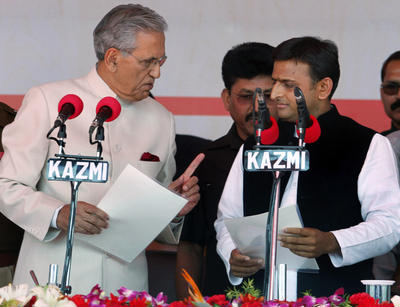While the Congress was not in the running to win outright in UP, the election was seen as a litmus test for Rahul Gandhi (general secretary of the Congress and great grandson of Jawaharlal Nehru, the first prime minister of independent India), who had concentrated his energies on the state for the past few years. Despite his efforts, the Congress won only 28 seats in the 403-seat UP Assembly. Even more disturbing was the Congress’ inability to win a majority of seats in Amethi and Rae Bareli. Rahul and his mother, Sonia Gandhi (the Congress president), represent these two constituencies in the Indian federal parliament, and this latest result brings into question the popularity of the Nehru-Gandhi brand.
The reasons for the Congress’ poor showing are as complex as the state of UP itself, with its multiple caste, class, religious and regional cleavages. But one likely reason was the Congress’ lack of organisation on the ground, and an over-reliance on Rahul to coordinate the party’s efforts. Another reason was the rejection of Congress’ negative campaign and its electoral promises, such as quotas for Muslims in government jobs and educational institutions, which was not well received by the electorate.
The UP election results surprised most analysts, who predicted a hung verdict in the state. Instead, the SP — a regional party and the original frontrunner — won a thumping majority. The wide margin of victory for the SP, which won 224 seats, and the abysmal performance of the governing Bahujan Samaj Party (BSP), winning only 80 seats, can be explained by five factors.
First, the incumbent Mayawati-led government in UP had become quite unpopular, primarily due to widespread corruption charges and wasteful high-cost projects to build statues of the chief minister, other Dalit icons and her party symbol, the elephant. The SP, a key player in UP politics since the early 1990s, was the best-placed party to reap the advantages of this anti-incumbency wave. It also promised stability, something the other parties were unlikely to provide.
Second, a relatively small swing in votes can bring about huge changes in the number of seats won. So, the SP’s 3.3 per cent vote advantage over the BSP gave it 144 extra seats.
Third, the SP had a relatively fresh face in Akhilesh Yadav, son of party president and former UP chief minister Mulayam Yadav, who seemed to connect well with voters. He cycled his way across the state (the bicycle is the SP’s electoral symbol) and was instrumental in putting together a slick ad campaign for his party — with the tagline ‘Umeed ki Cycle’ (Cycle of Hope). His promise of a ‘cleaner’ administration, despite the SP’s poor track record in government, struck a chord with voters, as did his emphasis on English-language education and the use of technology as key to the state’s growth.
Fourth, the Congress’ efforts to woo India’s Muslims, who constitute 18 per cent of the state’s population, backfired after the party promised a quota for ‘backward’ Muslims.
Fifth, it seems that some of the BSP’s core Dalit support base might have deserted it — with Dalits constituting around 21 per cent of UP’s population. And unlike the last election, Mayawati’s efforts to form a coalition cutting across castes was not successful, having alienated many of the upper castes and the Other Backward Classes, who felt she had been biased toward Dalits and Jatavs.
The larger story of the election results was not only the failure of the Congress but also the decline of its rival national party, the Bharatiya Janata Party (BJP), which scored 47 seats in UP. These elections can be seen as a triumph of regional parties over the national ones, a trend that has been gathering momentum over the last two decades. Several analysts have pointed out that the election result was a watershed verdict: the parties that spoke the language of aspiration and development were rewarded, and the Indian voter showed great maturity in rising above identity politics.
The medium-term implications of the election results do not look good for India. The Congress-led federal government has been in a state of paralysis for the past several months, hit by corruption scandals and troublesome allies which have blocked most major policy initiatives. The UP results make the situation even more grim for the Congress, which had hoped to play a decisive role in the formation of the UP state government and pick up a pliant ally in the federal coalition.
The Congress’ outlook for the 2014 federal elections does not look too bright either. But it would be foolhardy to make any concrete predictions based on the results in UP and the other states, as Indian voters vote differently in state elections. What is certain, however, is that difficult times lie ahead for the Indian government.
Ronojoy Sen is Visiting Research Fellow at the Institute of South Asian Studies, National University of Singapore.

